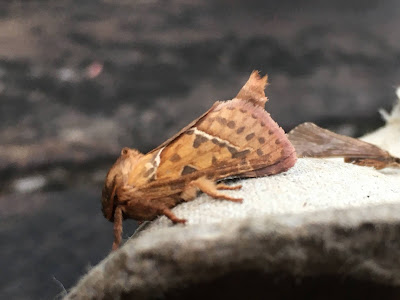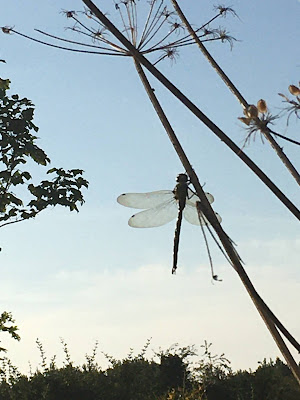Penny and I quite often discuss whether collecting is an overwhelmingly male pursuit and generally agree that the answer is yes. I am part of the evidence, in that the arrival of anything new in the moth trap gives me particular pleasure. And I have been very lucky in that regard over the years.
The unspectacular moth above is another to add to my tally - belatedly because I first featured it here at the end of a post on 8th August in which I celebrated my first visit from a Waved Black but ignorantly dismissed this moth as 'another variation of the Common or Lesser Common Rustic'.
So, warm thanks to the Commentor Pembrokeshire Birds who kindly suggested that the moth is actually a Crescent, an ID just confirmed by the expert Peter Hall on the invaluable Upper Thames Moths Blog. Up goes my tally again. I will add the numbers up again soon.
Meanwhile the moth trap keeps busy; this morning brought me the interesting trio of swift moths, above. The top one is a male Common Swift and the middle one a very nice and well-patterned male Orange Swift, so nice in fact that I thought at first that it might be a Map-winged Swift, a relative which has yet to pay me a call. The bottom moth, which is quite dramatically larger, is a female Orange Swift, albeit without the orange which is exclusive to the male. These moths - five of them in the swift family altogether with the other two being the even more jewel-like Gold Swift and the Ghost moth - have the distinction of coming first in the Moths Bible. Sadly, that is because they are among the most primitive of UK moths, with no proboscis and therefore no ability to feed. Here they are again, one by one and closer-to.

Another caller was the Small Square-spot, which I haven't seen for a while and to be honest wouldn't have recognised had it not been for recent mention of it on the Upper Thames Moths blog.
Out in the sunshine, meanwhile, P and I and a friend had an excellently long look at a very patient male Southern Hawker dragonfly. What a beautiful creature. If you see a dragonfly out patrolling, remember that they tend to fly in fairly confined areas and often come back to the plant or perch which they have only recently left.
 The sun has also brought out some pleasant blooms in our garden for insects to visit including this miniature-flowered version of Morning Glory and our Magnolia grandiflora whose vast waxy blooms share the very short life of the Morning Glories whose name derives from the fact that the flower lasts for less than a day.
The sun has also brought out some pleasant blooms in our garden for insects to visit including this miniature-flowered version of Morning Glory and our Magnolia grandiflora whose vast waxy blooms share the very short life of the Morning Glories whose name derives from the fact that the flower lasts for less than a day.And the butterflies and some moths like the sunlight too. Here is a Speckled Wood on our rhubarb, a quiet haven from the buddleia which is thronged with Red Admirals, Small Tortoiseshells, Painted Ladies and assorted Whites. And a Silver Y beneath the leaves of our Cooper's Burmese rose (a climber which I much recommend).










No comments:
Post a Comment